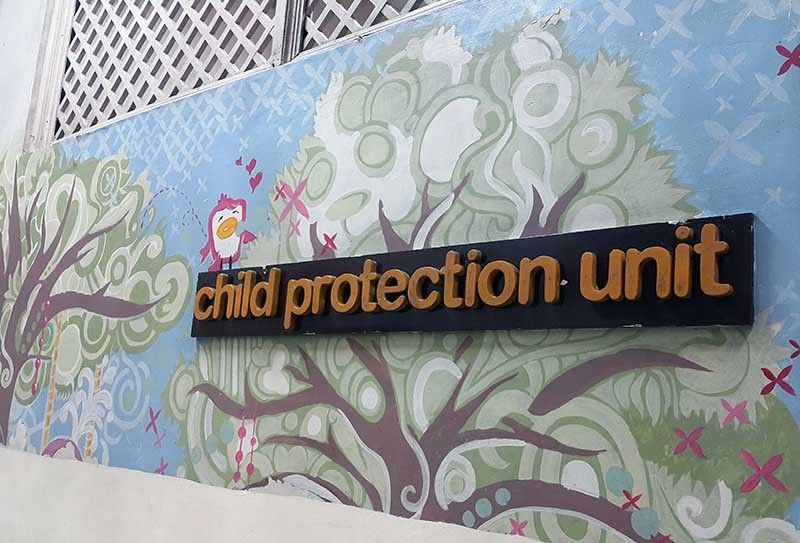Lack of psychologists in gov’t hospitals hampers healing of abused children

(First of two parts)
MANILA, Philippines — Ella (not her real name) was brought to the child protection unit of the Philippine General Hospital after a jeepney driver raped her when she was five years old. She was abused inside the jeepney where she and her family slept at night. A neighbor caught her abuser in the act.
Social workers immediately placed Ella in a shelter, which became her home for the next five years. There she was given therapy and provided counseling.
Based on assessments, Ella had delays in cognitive development. The social worker involved in Ella’s case said she repeated Grade 1 several times and eventually dropped out of school after her sophomore year because she couldn’t keep up with her classmates.
Ella lived with her grandmother after she left the shelter. Her mother then diligently accompanied her to counseling sessions. Fifteen years after the abuse, Ella, now 20, still attends sessions with her psychologists.
In many cases, management of an abused child’s mental and emotional well-being is a long-term engagement.
Long waitlists
Ella’s plight underscores the importance of mental health interventions for abused children. But not all victims of child abuse get to have the same treatment. In government hospitals, the lack of mental health professionals specializing in child psychology hampers the effective treatment of children who have undergone trauma caused by abuse.
At the Child Protection Unit of the Philippine General Hospital, scheduling an abused child for therapy may take anywhere from three to six months.
As of late, there are a total of 460 patients waitlisted to be seen by the unit’s psychologists and psychiatrists, according to triage officer Jennalyn Casapao. (Triage is where patients are sorted according to the urgency of care required.) On average, CPU-PGH psychologists see 21 patients in a week, while the unit’s psychiatrists handle 16 patients weekly for counseling and therapy.
According to the World Health Organization, there are only two mental health professionals per 100,000 population in the Philippines.
Child psychologist Jason Barlaan says he is scheduled to see patients until March of this year. The same goes for one of his colleagues at the Mental Health and Wellness section of the CPU-PGH.
“At least we have a purpose for the new year. We already have something to do,” says Barlaan, who handles about four patients a day and spends an average of two hours per patient.
“If you’re dealing with kids, you’re also dealing with their parents,” he adds.
How abused chidlren are screened, assessed
The unit’s psychologists and psychiatrists are the last persons to see an abused child after a social worker, police, and physician have examined the case. It is only then that the child undergoes psychological screening and is scheduled for counseling and therapy.
When a child is first brought to the CPU-PGH—usually by referral from the police, social welfare office of a local government unit (LGU), barangay officials, and private physicians—a social worker conducts an in-take assessment to get the basic details of the child and a safety assessment, which determines, among other things, whether or not it is safe for the child to go back home.
The doctor performs a medico-legal examination of the child to see if, for instance, the child contracted a sexually transmitted infection (STI). Depending on the findings, the doctor and social worker will commence a debriefing or safety planning, which includes medical follow-ups and psychological screening schedules. For high-risk cases—such as when a child exhibits risk-taking behavior or if the parents lack the capacity to protect the child—the social worker conducts a home visit within the next five days.
The entire process should take only one day from the time the child is initially brought to the CPU, says Annaliza Macababbad, supervising social worker at the CPU-PGH. With two doctors and two social workers, the CPU-PGH receives an average of five cases of child abuse per day. On some days, the number can go up to 10.
Macababbad says the CPU adjusts schedules on a case-to-case basis. If the child is considered high-risk based on initial assessments, such as if the abuse happened within the past 24 hours or if the perpetrator still has access to the child, then he or she will be given priority.
CPUs use a toolkit called PTAQ, or Psychological Trauma Assessment Questionnaire, to determine who needs immediate psychiatric evaluation and those who can be given psycho-education, which even non-psychologists or non-psychiatrists can provide. During psycho-education, patients are told that it is not their fault. They are taught deep breathing exercises to help them relax. Doctors say this helps victims of child abuse begin to recover.
Importance of counselling
For other patients, the wait to see a counselor is too long. Macababbad says that there are some whose schedules are so far off, they’ve already forgotten about it by the time their turn came along. They simply don’t show up at all, while some parents don’t see the need for their children to undergo therapy anymore.
Ideally, abused children who have been brought to the CPU will receive counseling as part of the healing process. But since social workers can only do so much in terms of follow-ups, it is ultimately up to the patients or at least the ones taking care of these kids to bring them to their appointments with a counselor.
Barlaan recalls one patient whose mother didn’t let her then 13-year-old daughter receive any form of psychological intervention after experiencing abuse. The stigma attached to seeing a counselor is still prevalent, he says.
For the next 13 years, the daughter went on to have a family of her own, not realizing the long-term effects she carried with her. She became submissive to her husband and thought of herself as a mere “machine,” existing only to earn money for her family. It was only until she found out that one of her children was a victim of abuse that her own memories of abuse came flooding back.
“She went back here, [crying],” Barlaan shares, “So naulit yung abuse na nangyari sa kanya. Everything, bumalik sa kanya lahat (So the abuse that she had experienced was repeated. Everything, she relived everything).”
Impact of child abuse
Sadly, it is not uncommon to hear such cases where the mother was first a victim and then her child becomes a victim as well. Ella’s mother was herself a victim of domestic violence.
“Nasu-surprise ako na pasyente namin yung nanay dati tapos yung anak pasyente rin namin (I am surprised that the mother is a former patient and now the child is our patient, too),” Barlaan says.
Many victims of abuse see themselves as inferior, which later on affects the way they parent their kids. That is why there seems to be a pattern, Barlaan explains. “Ano bang i-instill sa kanila ng mga perpetrators nila? ‘You’re nothing’, ‘Kung magsumbong ka, papatayin ko sila’ (What do their perpetrators instill in them? 'You're nothing', 'If you report [to authorities], I will kill them') … so there’s a presence of fear” he says, “Lahat yun, bitbit nila (All of that [emotional baggage], they carry).”
Child abuse may impact several dimensions of the victim’s life—social, personal, and psychological. The effects could be long-term, such as when a female rape survivor becomes hyper-vigilant in dealing with males or avoids situations that remind her of the abuse.
Barlaan explains that the goal of therapy or counseling is to minimize or prevent the problem from “exploding” into the other aspects of a person’s life.
Both Barlaan and Macababbad agree that the environment plays a key role in the healing of the child. For families who don’t prioritize the child, or worse, don’t believe the child when told of the abuse, the healing will be an uphill battle even with therapy.
Some are more resilient than others. “Even without counseling or rehabilitation, they can cope,” Barlaan says. There are kids who, after one or two sessions, already exhibit vast improvement.
There are some, he notes, who don’t need therapy, while there are kids whose symptoms arise only months after the abuse.
It depends on the child’s coping mechanism, says Dr. Renee Neri, pediatrician and child protection specialist. By simply talking about it in the initial interviews, some children are relieved, even by some small measure, of the burden of trauma brought on by abuse. Knowing that there are people who believe what they are saying is true becomes part of their healing.
Cases continue to rise
Child abuse—as defined in Republic Act No. 7610 (Special Protection of Children Against Abuse, Exploitation, and Discrimination Act)—refers to the maltreatment of the child in a physical, psychological, or sexual nature. This also includes neglect and unreasonable deprivation of his or her basic needs for survival.
Data from the Child Protection Network (CPN), a non-profit organization working with the government in establishing Women and Children Protection Units (WCPUs), shows that in 2017 there were over 9,000 new cases of violence against children all over the country—an increase of over a thousand cases from the previous year.
Reported cases of child abuse have been steadily increasing, coinciding with the addition of new WCPUs. In 2010, the number of child abuse cases was reported at 3,686, and jumped to 6,093 cases in 2012. An annual report of the CPN showed the network of WCPUs expanded to 62 in 2012 from 38 in 2010.
Sexual abuse was the most commonly reported form of abuse, followed by physical violence. Other forms include emotional abuse, neglect, and violence perpetrated by a minor.
The National Baseline Study on Violence Against Children, the first ever study of its kind in the Philippines, found that 3 out of every 5 Filipino children experience some form of physical violence during childhood, with more than half of these cases occurring at home. According to the study, the most common forms of physical violence include being spanked with the hands or rolled magazine, beaten with a belt, or locked in a small space.
The study, published in 2016, also found that only 29 percent of children were aware of the services available to them, particularly the CPUs.
LGUs are generally ill-equipped to prevent and respond to incidents of violence against children, the report also showed. Local social welfare offices are often under-staffed, leaving the social worker to juggle multiple tasks. Apart from that, the availability of funds remains a hindrance to the implementation of child protection programs.
“The one percent internal revenue allotment (IRA) for children is mostly spent on purposes other than to combat child abuse and neglect,” according to the National Baseline Study.
'Adequate' budget needed
A report on the women and children protection program by the Department of Health (DOH) said that a “consistent and adequate budget is necessary to sustain a women and children protection unit once it is established.” However, the report also pointed out that the “source of budget cited in A.O. 1-B is subjected to multiple interpretations and is dependent on the priorities of the local chief executive and/or the healthcare facility management.”
Under the 2011 General Appropriations Act (GAA) of the Department of Budget and Management, “all departments, bureaus, offices, agencies, SUCs [state universities and colleges], GOCCs [government owned and controlled corporations], and LGUs shall formulate a Gender and Development (GAD) Plan,” which will be at least 5% of their respective budgets. The plan shall be designed to address gender issues, particularly those concerning women and children.
But in practice, many government agencies fail to use this budget for more substantial programs. Neri confirms that there are some who don’t know how to spend their allotment and use it instead for Zumba classes.
Neri says the state of the CPU is still dependent on the priorities of the hospital director or the LGU. Another roadblock is the willingness of current hospital staff to handle child abuse cases.
“Dapat kasi kung CPU ka, calling mo yan. Kasi medyo mabigat siya (If you are with CPU, it should be your calling. Because it's demanding),” Neri explains.
(Marishka M. Cabrera is a writer and editor of Inc. Southeast Asia, a media brand for start-ups and entrepreneurs in the region. She is taking her MA in Journalism at the Ateneo de Manila University under the Adenauer Fellowship for Media & Communication in Asia.)
(VERA Files is put out by veteran journalists taking a deeper look at current issues. Vera is Latin for “true.”)
- Latest
- Trending





























